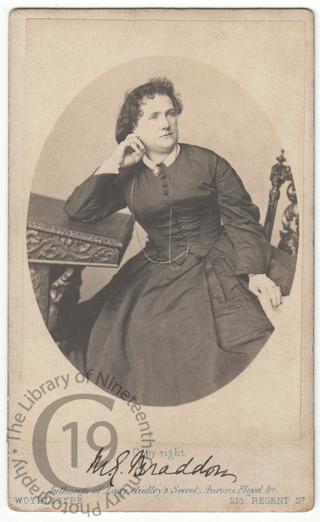
Mary Elizabeth Braddon
A carte de visite portrait of Mary Elizabeth Braddon (1835-1915), one of Victorian England’s best loved writers. She was also one of the century’s most prolific, with a phenomenal output that included 80 novels, 5 plays and numerous short stories and poems. She is acknowledged as one of the inventors of the genre of sensation fiction.
Her most successful works were lurid thrillers with melodramatic plots, repackaging the traditions of the working-class penny-dreadful for a middle-class audience. Critics maintained of her books that ‘excitement and excitement alone seems to be the great end at which they aimed’ and she was criticized for bringing the literature of the kitchen into the drawing room. She herself had no illusions about the literary value of her work, commenting to her friend Bulwer-Lytton that ‘the amount of crime, treachery, murder, slow poisoning and general infamy required by the halfpenny reader is something terrible.’ Under constant pressure to publish, she also complained that she was ‘always divided between a noble desire to attain something like excellence and a very ignoble wish to earn plenty of money.’
Braddon broke into the mainstream market with Lady Audley’s Secret (1862), a tale of a beautiful, homicidal bigamist which became an instant best-seller. Shocked critics condemned it as ‘one of the most noxious books of modern times’ but Henry James loved it and even Queen Victoria was said to have read it. He next novel Aurora Floyd further scandalised critics with a scene that quickly became notorious, in which the beautiful heroine horsewhips a male stable hand.
Her books declined in popularity after her death in 1915, but have recently enjoyed a notable revival and critical reassessment, not least for their aspects of proto-feminism. One theme that recurs throughout her work is the discontent of women with their place in society. Her pivotal place in nineteenth-century popular culture now receives the appreciation it deserves and her memorial in Richmond Church describes her as a ‘a writer of rare and refined scholarship who gave profitable and pleasurable literature to countless readers.’
[For a far more nuanced assessment of Braddon’s career, see Jennifer Carnell’s The Literary Lives of Mary Elizabeth Braddon, published in 2000 by Sensation Press.]
Photographed by the United Association of Photography Limited. Entered at Stationers’ Hall – an essential part of the copyright process – on 28 June 1865. Printed with a facsimile of the sitter’s signature recto in the lower margin.
Code: 127531




